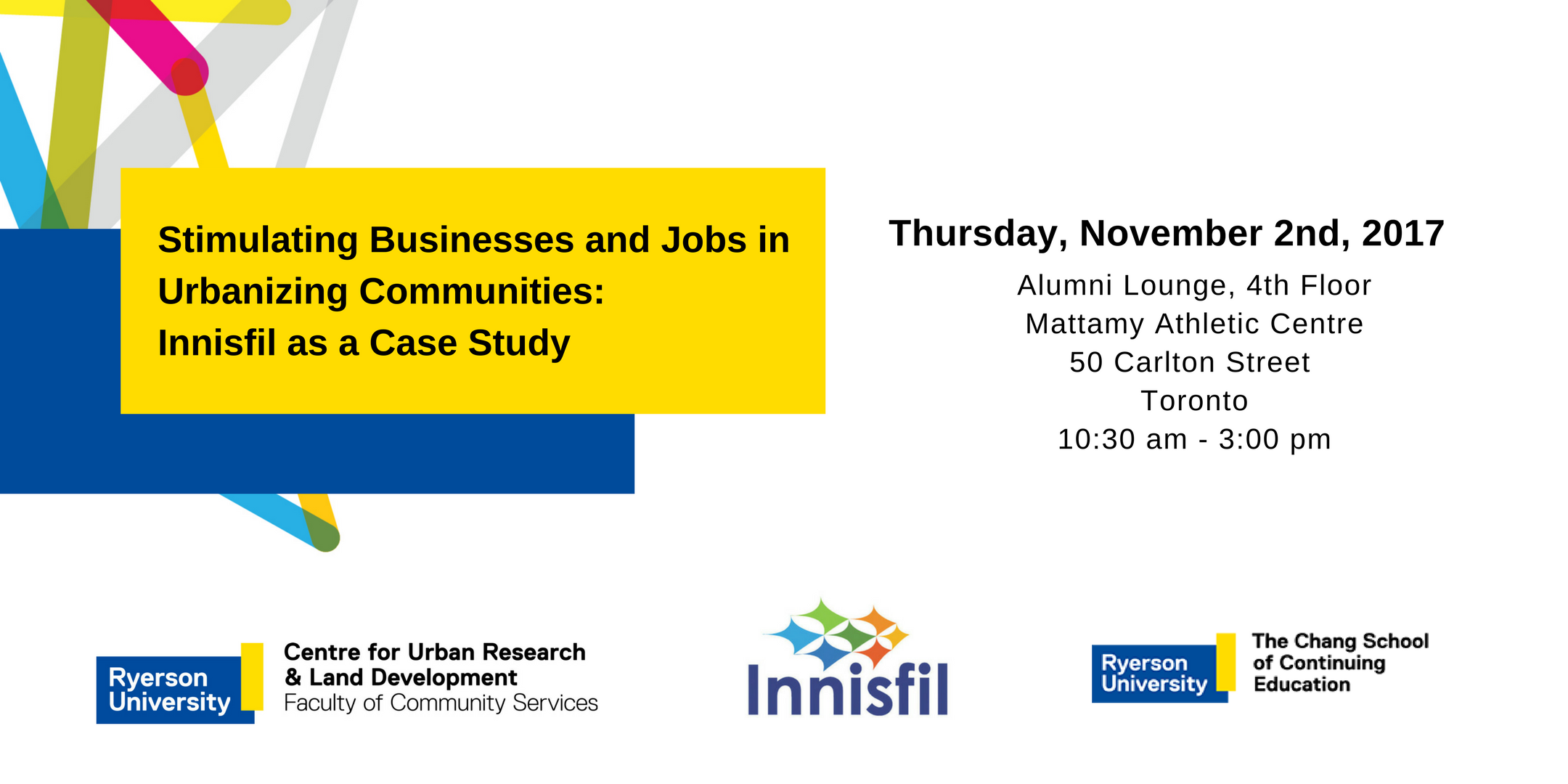News & Events
Stimulating Businesses and Jobs in Urbanizing Communities: Innisfil as a Case Study
The Challenge of Creating Jobs in a Rapidly Growing Smaller Municipality
By: Matthew Taylor U E
Researcher, Centre for Urban Research and Land Development
On November 2nd, 2017 a group of experts gathered at Toronto Metropolitan University to join in a discussion around the challenge of urbanization for the Town of Innisfil in Simcoe County with the focus being on job creation. Pulling on the knowledge base of industry professionals, academics, and students, this workshop set out to create direction for other smaller municipalities on how to compete for jobs within the Greater Golden Horseshoe (GGH).
The day began with the Town’s staff and consultants providing a snapshot of what is happening in Innisfil. The presentations described what many small but rapidly growing towns are experiencing - burdens of spatial mismatch, a fiscal crunch, land speculation and what is called the bureaucratic planning onion. What came out of the day was that Innisfil's long term economic success depends on developing Innisfil Heights, but also some near-term feasible solutions including: building a downtown core, enhancing quality of life through amenities, and creating innovative space for entrepreneurship.
The main objective of the day was to explore solutions on how to bring jobs to the Town of Innisfil and create opportunities for out-commuting to drop (as 84% of the working aged population now commutes out of the town for work). Innisfil Heights, a large swath of greenfield land adjacent to Highway 400 designated for employment uses, was described as the Town’s biggest asset. The only negative for these lands is that they are unserviced for wastewater. The cost (estimated at $150 million) to service it would put Innisfil in a budget crunch and likely render the lands too expensive to attract development.
The afternoon began with a panel discussion during which experts made recommendations on how to protect the longevity of Innisfil Heights from short term actions. There was a consensus among panelists that over the long term, servicing Innisfil Heights is an important step to economic prosperity but there is a need to wait for the demand and density to support the high costs. Panelists cautioned that traditional infrastructure priorities might not be the right bait for the big fish they’re looking to catch.
Looking more towards the immediate term, the Town’s representatives proposed the option of financial incentives to attract innovation-focused businesses such as angel funding and “Shark Tank” like grants. Panelist Diana Petramala observed that a large body of economic research suggests the returns on incentives may not be the most successful model for attracting businesses. Instead she emphasized the desirability of improvements to quality of life and property tax adjustments. In her view, the Town should invest in Alcona as their downtown, providing innovation space and high level digital services to support entrepreneurs, amenities to support the tourism and recreational industry, promoting restaurants or similar services.
The Town representatives also discussed the woes of pre-zoning downtown Alcona stating that the zoning change seemed to increase asking prices for the properties but has not spurred the more intense development they had hoped to see.
Panelist Frank Miele asserted that he appreciated the Town’s willingness to be “disruptive” and open to new ideas. Using Uber as their public transit service is an example of the Town’s innovation. He then focused on the long term vision of differentiating themselves, using examples such as Toronto or Hamilton being known for high finance and manufacturing respectively. Similarly, with the Town’s anticipated GO station, they are faced with the challenge of becoming a known destination and not just a commuter connection to Toronto.
Panelist Brock Dickinson stated that today’s economy is really a competition between networks not businesses. He highlighted the importance of providing physical space and interaction opportunities for entrepreneurs, specifically providing innovation space. He also emphasized focusing on the people you have now, building your existing human capital.
Panelist Jo Flatt dived into the deeper observations of the quality of life conversation, highlighting the need to determine and state what qualities the Town has and wants, and how to strengthen them. She continued by emphasizing public consultations in determining and developing these quality of life factors.
The conversation mainly focused on short term actions of building your current assets around quality of life, human capital (specifically entrepreneurs) and sense of place. Realizing the long term asset of Innisfil Heights will only be strengthened or made possible by these factors.
Videos of the Event:
Part 1: Innisfil background and situational analysis
Part 2: Expert panel discussion
Innisfil Consultants and Staff
- Jason Reynar, Chief Administrative Officer, Town of Innisfil
- Tim Cane, Manager of Land Use Planning, Town of Innisfil
- Dan Taylor, Economic Development Catalyst, Town of Innisfil
- Jamie Cook, Director, Watson & Associates Economists Ltd.
(PDF file) Town of Innisfil's presentation >>
(PDF file) Jamie Cook's presentation >>
Expert Panelists
- Frank Miele, Academic Coordinator and Instructor, Certificate in Local Economic Development Program, Toronto Metropolitan University
- Diana Petramala, Senior Researcher, Centre for Urban Research and Land Development (CUR), Toronto Metropolitan University
- Brock Dickinson, Entrepreneur in Residence, University of Waterloo
- Jo Flatt, Senior Manager, Policy & Partnerships, Evergreen
Moderator
- Frank Clayton
Senior Research Fellow
Centre for Urban Research and Land Development (CUR)
Toronto Metropolitan University
